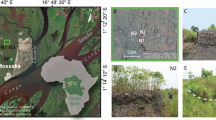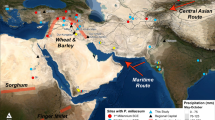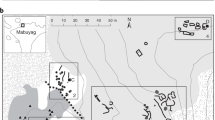Abstract
In spite of recent progress towards an understanding of prehispanic Maya agriculture, relatively little is known about plants grown prehistorically in the Petén, Belize and the Yucatan Peninsula. Little plant material has been reported from Maya sites, and almost no detailed archaeobotanical analyses have been done. The Cuello site (18°05′N, 88°35′W) in northern Belize is unique in having numerous intact floors of very early ceremonial structures which separate plant remains into clearly defined units. Flotation of soil samples has yielded a wide range of carbonized plant material including many maize cupules (cob fragments) and kernels. As we report here, these can be classified into several types which seem to relate to a range of archaeological types of maize found elsewhere.
This is a preview of subscription content, access via your institution
Access options
Subscribe to this journal
Receive 51 print issues and online access
$199.00 per year
only $3.90 per issue
Buy this article
- Purchase on Springer Link
- Instant access to full article PDF
Prices may be subject to local taxes which are calculated during checkout
Similar content being viewed by others
References
Hammond, N. (ed.) Cuello Project 1978 Interim Report. Publ. no. 1 (Archaeological Research Program, Douglass College, Rutgers University, 1979).
Hammond, N. Belizean Stud. 8, 33–44 (1980); Belizean Stud. (in the press).
Hammond, N. et al. Am. Antiq. 44, 92–110 (1979).
Hammond, N. et al. Nature 260, 579–581 (1976); 267, 608–610 (1977).
Hammond, N. Am. Antiq. 44, 92–110 (1979).
Minnis, P. E. & LeBlanc, S. Am. Antiq. 41, 491–493 (1976).
Bird, R. McK. thesis, Univ. California, microfilm 71–9767 (1970).
Bird, R. Mck. Maize Genet. Coop. News Lett. 52, 90–92 (1978).
Bird, R. Mck. Maize Genet. Coop. News Lett. 53, 53–54 (1979).
Bird, R. Mck., & Bird, J. B. Am. Antiq. 45, 325–332 (1980).
Nickerson, N. H. Ann. Mo. Bot. Garden 40, 79–111 (1953).
Cutler, H. C. Univ. Utah Anthr. Pap. 80, 10–11 (1966).
Bird, R. Mck. & Goodman, M. M. Econ. Bot. 31, 471–481 (1978).
Smith, J. S. C. & Lester, R. N. Econ. Bot. 34, 201–218 (1980).
Wellhausen, E. J. et al. Races of Maize in Mexico (Bussey Institute, Harvard University, Cambridge, 1952).
Wellhausen, E. J. Races of Maize in Central America, Publ. 511 (National Academy of Sciences-National Research Council, Washington DC, 1957).
Mangelsdorf, P. C. et al. Bot. Mus. Leafl., Harvard Univ. 17, 125–150 (1956).
Mangelsdorf, P. C. et al. Bot. Mus. Leafl., Harvard Univ. 22, 33–62 (1967).
Ford, R. I. in Prehistory and Human Ecology of the Valley of Oaxaca (ed. Flannery, K. V. ) Mem. Mus. Anthr. Univ. Mich. no. 8, 4, 261–268 (1976).
Author information
Authors and Affiliations
Rights and permissions
About this article
Cite this article
Miksicek, C., Bird, R., Pickersgill, B. et al. Preclassic lowland maize from Cuello, Belize. Nature 289, 56–59 (1981). https://doi.org/10.1038/289056a0
Received:
Accepted:
Issue Date:
DOI: https://doi.org/10.1038/289056a0
This article is cited by
-
Beyond the Ecofact: Toward a Social Paleoethnobotany in Mesoamerica
Journal of Archaeological Method and Theory (2015)
-
Bibliography of american archaeological plant remains (II)
Economic Botany (1990)
-
Economic plant species associated with prehistoric agriculture in the Maya lowlands
Economic Botany (1984)
-
Literatur über archäologische Kulturpflanzenreste (1980/1981)
Die Kulturpflanze (1982)
Comments
By submitting a comment you agree to abide by our Terms and Community Guidelines. If you find something abusive or that does not comply with our terms or guidelines please flag it as inappropriate.



